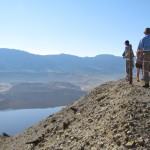Cfwep.org is made up of a staff of individuals whose personal values align with the core values of our organization – to help create environmental stewards through education. With our multi-disciplinary Restoration Education Program, Cfwep.Org uses an inquiry-based, place-based approach to teach watershed science to students throughout the Clark Fork watershed. Our goal is not to tell students what to think or believe, but rather to give them the tools they need to think for themselves, to think critically and to make informed decisions with regards to their environment.
Cfwep.Org’s Restoration Education Program (REP), also known as the Base-level curriculum, touches upon the heart and soul of our organization. The objective of our five day REP curriculum is to teach about the restoration of the Clark Fork River – its social and cultural history; the scientific processes involved in the restoration; and the importance of restoration and the need for environmental stewards or protectors. Each year, Cfwep.Org visits with approximately 2,700 students throughout the Clark Fork watershed to present the REP curriculum. Our curriculum uses the local environment as the basis for teaching about the Upper Clark Fork River’s restoration, incorporating concepts from biology, chemistry, ecology, mathematics, history, and yes, even art!
environment as the basis for teaching about the Upper Clark Fork River’s restoration, incorporating concepts from biology, chemistry, ecology, mathematics, history, and yes, even art!
In the Fall semester, we serve all 7th grade science students at East Middle School, as well as science students from Drummond’s 7th and 10th grade classes. In the Spring semester, we work with students in Ramsay, Anaconda, Philipsburg, Butte Central, and Deer Lodge. The first four days of our program are spent in the classroom teaching the concept of a watershed; the ecological roles of riparian habitats; the history of mining copper in our region; the basic geology of our region; the processes involved in copper extraction; the Superfund designation given to our region due to mining impacts; and the current remediation and restoration efforts that are going on in our watershed. On the fifth day of our program, we take a field trip to a mine-waste impacted site.
As the restoration has proceeded, we have been moving downstream in search of mine-waste impacted sites; for the last three years, including this current one, our field trip site has been on Silver Bow Creek at Fairmont Road. While at the site, students collect data with the aid of volunteer station leaders on water quality, riparian habitat characteristics, and aquatic macroinvertebrates. This data is used to assess the health of the riparian habitat. We review the data in a classroom; if possible we bring the students to Montana Tech’s campus so that they can experience a college classroom setting.
The theme of our current newspaper is Art and the Environment, and we mentioned earlier that art does have a role in our science curriculum. So you may be asking yourself, “how is art incorporated into the REP curriculum?” Well, first of all, during every classroom visit, we provide colorful markers and blank sheets of paper for students to color, draw, and write about the concepts being discussed. These sheets, called RAP sheets (Rapid Assessment Program), become quite colorful and serve as an information and resource guide for the students’ personal use. If we have more time in the classroom, we give students the opportunity to build models. For example, during our visit with Garrison School in Fall 2011, we brought a large bin of arts and crafts supplies that included fuzzy wire, markers, feathers, and pom poms, as well as recycled materials such as cardboard and Styrofoam. With these materials, students were asked to create a model of a healthy riparian habitat, and boy, did the students deliver! We were amazed by their talent and creativity, and were impressed by how they incorporated ecological concepts we taught through our curriculum into their models. Their riparian habitats supported an amazing display of biodiversity, and the students even wrote stories to explain how their riparian habitats functioned. We plan to do the same thing this spring (2013) with Butte Central Elementary’s 5th grade science class. To see pictures of the riparian habitat models created by the wonderfully talented 5th grade students, please visit and “like” our Facebook page, or visit www.cfwep.org to learn more about REP and other Cfwep.Org programs.
